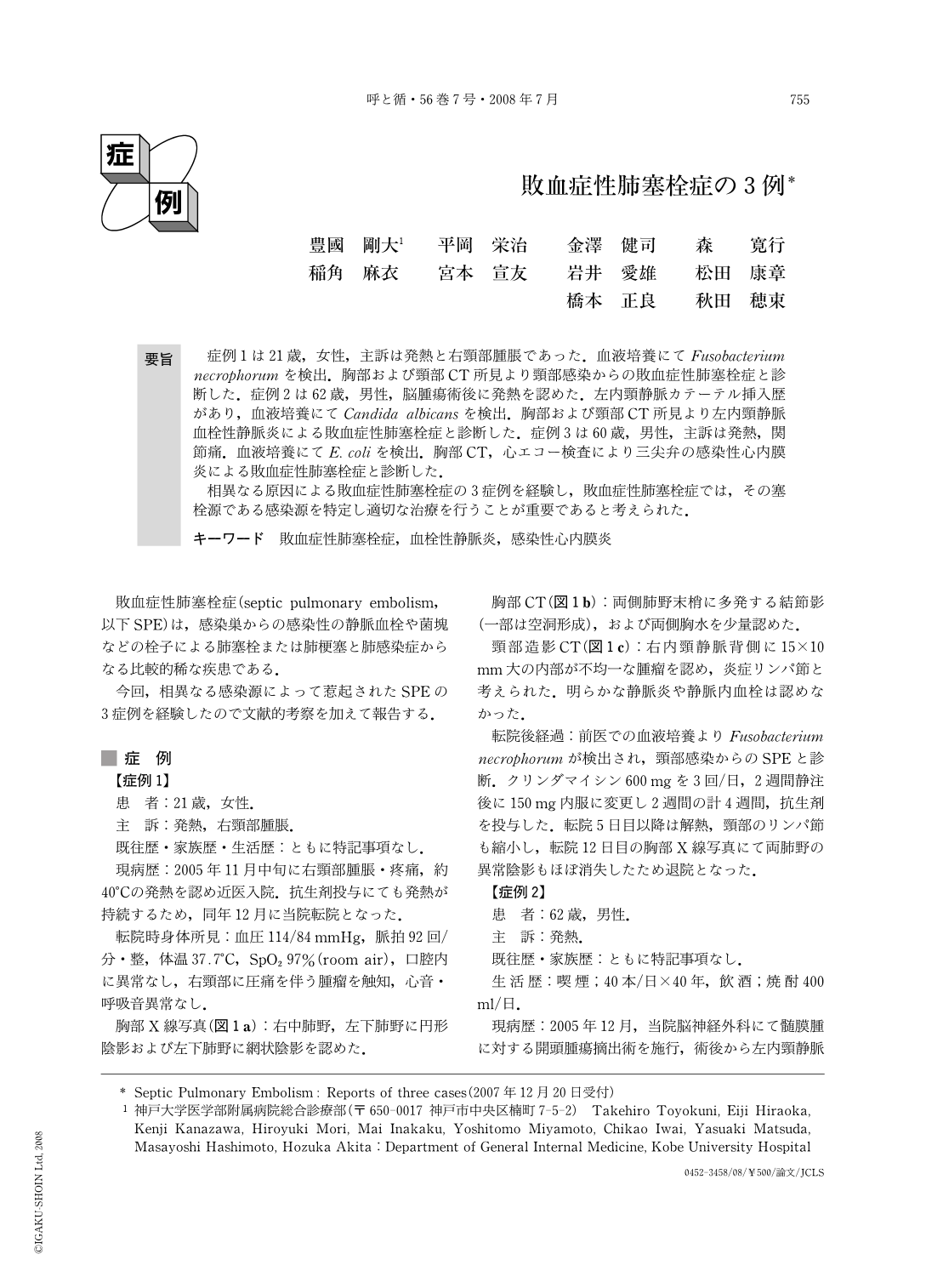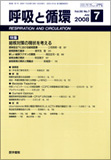Japanese
English
- 有料閲覧
- Abstract 文献概要
- 1ページ目 Look Inside
- 参考文献 Reference
要旨 症例1は21歳,女性,主訴は発熱と右頸部腫脹であった.血液培養にてFusobacterium necrophorumを検出.胸部および頸部CT所見より頸部感染からの敗血症性肺塞栓症と診断した.症例2は62歳,男性,脳腫瘍術後に発熱を認めた.左内頸静脈カテーテル挿入歴があり,血液培養にてCandida albicansを検出.胸部および頸部CT所見より左内頸静脈血栓性静脈炎による敗血症性肺塞栓症と診断した.症例3は60歳,男性,主訴は発熱,関節痛.血液培養にてE.coliを検出.胸部CT,心エコー検査により三尖弁の感染性心内膜炎による敗血症性肺塞栓症と診断した.
相異なる原因による敗血症性肺塞栓症の3症例を経験し,敗血症性肺塞栓症では,その塞栓源である感染源を特定し適切な治療を行うことが重要であると考えられた.
We encountered three cases of septic pulmonary emboli(SPE).
Case 1: a twenty-one-year-old female developed fever and tender swelling in the right side of her neck. Her blood culture produced Fusobacterium necrophorum. CT scan of her chest showed multiple necrotic infiltrates and neck CT scan showed lymphadenitis. She was diagnosed as SPE. She was treated successfully with a four-week course of antibiotics.
Case 2: a sixty-year-old male underwent craniotomy for resection of a meningioma. After that, a central line in the left internal jugular vein had been inserted for total parenteral nutrition. He began to experience fever and positive blood culture of Candida albicans 1 month later. CT of his chest showed multiple infiltrates. CT of the neck showed thrombophlebitis in the left internal jugular and subclavian vein. Transesophageal echocardiography was negative for infectious endocarditis. These finding demonstrated SPE secondary to septic thrombophlebitis due to the central line. The catheter was removed and he was treated successfully with a 6-week course of fluconazole intravenously and anticoagulation.
Case 3: a 60-year-old male with alcoholic liver cirrhosis was admitted to another hospital with fever and multiple joint pains. Blood culture was persistently positive for E.coli even after the initiation of antibiotic treatment. Therefore, he was transferred to our hospital. His chest X-ray and CT scan showed multiple infiltrates, which was consistent with SPE. To discover the etiology of SPE, echocardiography was performed. It showed tricuspid endocarditis. He was also found, by MRI and CT scan, respectively, to have osteomyelitis in the cervical vertebra and pelvic bone and an abscess in the right thigh. He was treated successfully with a 15-week course of antibiotics.
Diagnosis of SPE is usually made by typical findings of chest X-ray and CT scan, including multiple infiltrates, feeding vessel sign, and cavitary formation. The source of SPE is tricuspid valve endocarditis, septic thrombophlebitis due to an intravenous catheter, illicit drug abuse, and neck infection. This is usually treated with antibiotics. Sometimes, surgical resetion of the infected vein or anticoagulation is necessary for septic thrombophlebitis. Drainage is sometimes required for an abscess. Therefore, it is important to identify the source of infection when SPE is diagnosed.

Copyright © 2008, Igaku-Shoin Ltd. All rights reserved.


